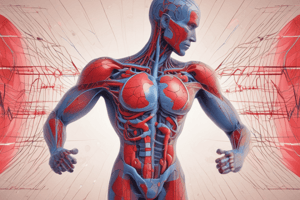Podcast
Questions and Answers
An increase in training can lead to an increase in heart mass by as much as 33% or .1% BW and an increase in chamber diameter & wall thickness, resulting in an increase in __________.
An increase in training can lead to an increase in heart mass by as much as 33% or .1% BW and an increase in chamber diameter & wall thickness, resulting in an increase in __________.
Cardiac Output
During training, there is an increase in stroke volume, with one study finding a 10% increase. This contributes to better thermoregulation and aids in the elimination of waste products. Stroke volume refers to the volume of blood pumped by the heart with each __________.
During training, there is an increase in stroke volume, with one study finding a 10% increase. This contributes to better thermoregulation and aids in the elimination of waste products. Stroke volume refers to the volume of blood pumped by the heart with each __________.
Heartbeat
Horses undergoing cardiovascular changes due to training show remarkable adaptations, such as a high ratio of heart weight to BW, large mass-specific CO, and high __________.
Horses undergoing cardiovascular changes due to training show remarkable adaptations, such as a high ratio of heart weight to BW, large mass-specific CO, and high __________.
VO2max
Stroke Volume measures the amount of blood ejected by the ______ in one contraction
Stroke Volume measures the amount of blood ejected by the ______ in one contraction
Mitochondria are responsible for producing energy through ______ respiration
Mitochondria are responsible for producing energy through ______ respiration
Cardiac Output is the volume of blood pumped by the heart in one minute, calculated by multiplying heart rate by ______ volume
Cardiac Output is the volume of blood pumped by the heart in one minute, calculated by multiplying heart rate by ______ volume
Blood Pressure is the force of blood against the walls of the ______
Blood Pressure is the force of blood against the walls of the ______
VO2max is the maximum amount of oxygen a horse can utilize during intense exercise, a measure of aerobic ______
VO2max is the maximum amount of oxygen a horse can utilize during intense exercise, a measure of aerobic ______
The faster the blood is pumped by the heart, the higher the horse's ______ will be
The faster the blood is pumped by the heart, the higher the horse's ______ will be
Stroke Volume (SV) is the volume of blood pumped out of the heart at each beat. At rest, SV ranges from 1.3-2.3 ml/kg BW. During exercise, SV ranges from 2.5-2.7 ml/kg BW. SV increases by up to 50% during exercise and further increases with ________.
Stroke Volume (SV) is the volume of blood pumped out of the heart at each beat. At rest, SV ranges from 1.3-2.3 ml/kg BW. During exercise, SV ranges from 2.5-2.7 ml/kg BW. SV increases by up to 50% during exercise and further increases with ________.
Cardiac Output (CO) is the amount of blood pumped by the heart per minute. CO is calculated as HR X SV. At rest, CO ranges from 25-45 l/min. During exercise, CO ranges from 240-300 l/min. If we standardize for body mass, horses have twice the CO as humans. The formula for CO is CO = HR X ________.
Cardiac Output (CO) is the amount of blood pumped by the heart per minute. CO is calculated as HR X SV. At rest, CO ranges from 25-45 l/min. During exercise, CO ranges from 240-300 l/min. If we standardize for body mass, horses have twice the CO as humans. The formula for CO is CO = HR X ________.
Blood Pressure (BP) is calculated as CO X peripheral resistance. At rest, BP is typically 120/80. During submaximal exercise, BP remains relatively stable. However, during maximal exercise, BP can increase to ________.
Blood Pressure (BP) is calculated as CO X peripheral resistance. At rest, BP is typically 120/80. During submaximal exercise, BP remains relatively stable. However, during maximal exercise, BP can increase to ________.
Mean arterial BP tends to increase by approximately 70% during intense exercise. In contrast, the mean pulmonary artery pressure may increase by ________%.
Mean arterial BP tends to increase by approximately 70% during intense exercise. In contrast, the mean pulmonary artery pressure may increase by ________%.
Vo2max (maximal O2 uptake) refers to the maximum rate at which the body can use oxygen during intense exercise. It is mainly influenced by the cardiovascular system and the number of ________.
Vo2max (maximal O2 uptake) refers to the maximum rate at which the body can use oxygen during intense exercise. It is mainly influenced by the cardiovascular system and the number of ________.
Horses with high aerobic capacity have very high Vo2max levels. Their Vo2max can increase by up to 35 times over resting rates, making them twice as efficient as human athletes who have a Vo2max of 70 ml/kg/min. This difference is due to horses' superior ________.
Horses with high aerobic capacity have very high Vo2max levels. Their Vo2max can increase by up to 35 times over resting rates, making them twice as efficient as human athletes who have a Vo2max of 70 ml/kg/min. This difference is due to horses' superior ________.
Flashcards are hidden until you start studying




